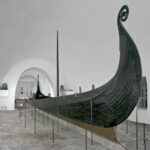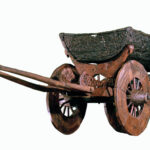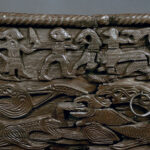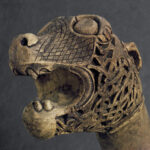On August 8, 1903, an archeologist by the name of Gabriel Gustafson investigated the farm of Lillie Oseberg in Slagen, Vestfold, Norway, after a burial mound was found on the property. The Oseberg ship was then excavated in 1904 from that burial mound, and through dendrochronological analysis (studying tree rings), the burial was ultimately dated to 834. The outer hull of the ship consists of overlapping oak strakes fixed with iron rivets and has been fully reassembled and constructed within the Viking Ship Museum in Oslo. The prow of the ship contains intricate decorative animal friezes in an animal style known as Style E, with an estimated carving date of 820. A grave chamber built aboard this ship contained the bodies of two females who died at roughly the same point in time.
- Ship from Oseberg, NO. Detail of stem. (source: KHM)
- Ship from Oseberg, NO. L 21.5 × B 5.1 m (source: KHM)
- Ship from Oseberg, NO. Detail of keel. (source: KHM)
Further photos of the Oseberg Ship at UNIMUS.
Osteological analysis has revealed the ages of both females. One was aged in the 60-70 range, while the other was significantly younger, at about 50 years old. Given the exceptional contents of this burial, it is believed to have been for royalty, observed through several complex wood-carved objects, including a cart and animal head posts.
- Cart from Oseberg, NO. 5.5×1.5 m. (source: KHM)
- Cart from Oseberg, NO. Detail of back. (source: KHM)
- Carved post from Oseberg, NO. Animal head, H 50 cm. (source: KHM)
Further photos of the Oseberg cart and carved post at UNIMUS.
Additional finds included the Oseberg cart. Found within the ship burial, the cart was constructed from oak and may be separated into several modular pieces. The body of the cart is removable but held in place by cradles decorated with animalistic carvings and ending in human heads. A striking feature of this object is its narrative scenes. As James-Graham-Campbell (2021) describes it:
On the front there is a depiction of a bearded man surrounded by snakes. Chains of ‘ribbon-animals’ decorate its sides, interrupted in one place by a dramatic scene (of unknown significance) being enacted between three figures: a man holding a weapon in his right hand confronts a rider, who is accompanied by a hound. The raised arm of the standing man is restrained by a woman, with flowing hair, who is wearing an elaborate necklace.
Due to the vivid details observed on the cart and in several objects of the Oseberg burial, it has been suggested that the burial actually contains the bodies of a legendary Queen Åsa as well as a female priest. According to the researcher Per Holck (2006):
The legend which portrays that a certain ‘Queen Åsa’ was buried inside the ship and gives her name to the mound and its surroundings has been kept alive for decades. In actuality, little is known about her existence, with the exception of that which is revealed in a few words from Snorri Sturluson’s Sagas from the 13th century … It has also been suggested that the younger woman in the Oseberg ship may have been a so-called ‘hovgydje’ or female priest who was sacrificed, an assumption based on the broken skull and the fresh fracture of the clavicle. More probably, though, the defects and deformities of the skull are postmortem, a result of pressure from the soil masses in the mound, and the fractured clavicle is certainly neither proof of offering nor of any social relationship. Little is known about the female priests of that time, and so it remains unknown, too, whether they enjoyed a social status that could relate to the sumptuousness of the Oseberg find, as has been pointed out by the historian Magnus Olsen.
Given these ambiguities, it is difficult to say for certain who each of the female individuals was in the Oseberg ship burial. Even so, the resources and valuable grave goods that comprised the burial site were immense, thereby demonstrating a rare, but overt example of powerful female presence during the Viking Age.
« Previous | Home | Next »





